Jiafu Wu
SwiftVideo: A Unified Framework for Few-Step Video Generation through Trajectory-Distribution Alignment
Aug 08, 2025Abstract:Diffusion-based or flow-based models have achieved significant progress in video synthesis but require multiple iterative sampling steps, which incurs substantial computational overhead. While many distillation methods that are solely based on trajectory-preserving or distribution-matching have been developed to accelerate video generation models, these approaches often suffer from performance breakdown or increased artifacts under few-step settings. To address these limitations, we propose \textbf{\emph{SwiftVideo}}, a unified and stable distillation framework that combines the advantages of trajectory-preserving and distribution-matching strategies. Our approach introduces continuous-time consistency distillation to ensure precise preservation of ODE trajectories. Subsequently, we propose a dual-perspective alignment that includes distribution alignment between synthetic and real data along with trajectory alignment across different inference steps. Our method maintains high-quality video generation while substantially reducing the number of inference steps. Quantitative evaluations on the OpenVid-1M benchmark demonstrate that our method significantly outperforms existing approaches in few-step video generation.
Swin DiT: Diffusion Transformer using Pseudo Shifted Windows
May 19, 2025Abstract:Diffusion Transformers (DiTs) achieve remarkable performance within the domain of image generation through the incorporation of the transformer architecture. Conventionally, DiTs are constructed by stacking serial isotropic global information modeling transformers, which face significant computational cost when processing high-resolution images. We empirically analyze that latent space image generation does not exhibit a strong dependence on global information as traditionally assumed. Most of the layers in the model demonstrate redundancy in global computation. In addition, conventional attention mechanisms exhibit low-frequency inertia issues. To address these issues, we propose \textbf{P}seudo \textbf{S}hifted \textbf{W}indow \textbf{A}ttention (PSWA), which fundamentally mitigates global model redundancy. PSWA achieves intermediate global-local information interaction through window attention, while employing a high-frequency bridging branch to simulate shifted window operations, supplementing appropriate global and high-frequency information. Furthermore, we propose the Progressive Coverage Channel Allocation(PCCA) strategy that captures high-order attention similarity without additional computational cost. Building upon all of them, we propose a series of Pseudo \textbf{S}hifted \textbf{Win}dow DiTs (\textbf{Swin DiT}), accompanied by extensive experiments demonstrating their superior performance. For example, our proposed Swin-DiT-L achieves a 54%$\uparrow$ FID improvement over DiT-XL/2 while requiring less computational. https://github.com/wujiafu007/Swin-DiT
UniCombine: Unified Multi-Conditional Combination with Diffusion Transformer
Mar 12, 2025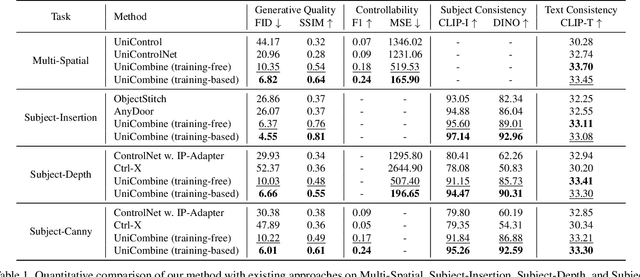
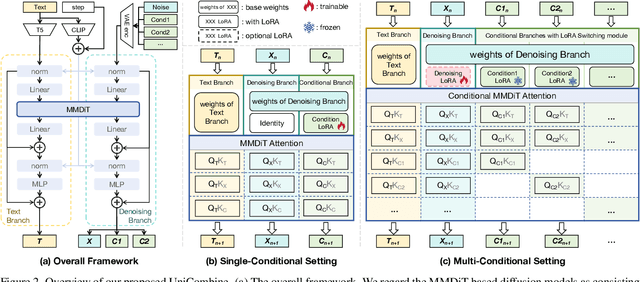


Abstract:With the rapid development of diffusion models in image generation, the demand for more powerful and flexible controllable frameworks is increasing. Although existing methods can guide generation beyond text prompts, the challenge of effectively combining multiple conditional inputs while maintaining consistency with all of them remains unsolved. To address this, we introduce UniCombine, a DiT-based multi-conditional controllable generative framework capable of handling any combination of conditions, including but not limited to text prompts, spatial maps, and subject images. Specifically, we introduce a novel Conditional MMDiT Attention mechanism and incorporate a trainable LoRA module to build both the training-free and training-based versions. Additionally, we propose a new pipeline to construct SubjectSpatial200K, the first dataset designed for multi-conditional generative tasks covering both the subject-driven and spatially-aligned conditions. Extensive experimental results on multi-conditional generation demonstrate the outstanding universality and powerful capability of our approach with state-of-the-art performance.
VI3DRM:Towards meticulous 3D Reconstruction from Sparse Views via Photo-Realistic Novel View Synthesis
Sep 12, 2024



Abstract:Recently, methods like Zero-1-2-3 have focused on single-view based 3D reconstruction and have achieved remarkable success. However, their predictions for unseen areas heavily rely on the inductive bias of large-scale pretrained diffusion models. Although subsequent work, such as DreamComposer, attempts to make predictions more controllable by incorporating additional views, the results remain unrealistic due to feature entanglement in the vanilla latent space, including factors such as lighting, material, and structure. To address these issues, we introduce the Visual Isotropy 3D Reconstruction Model (VI3DRM), a diffusion-based sparse views 3D reconstruction model that operates within an ID consistent and perspective-disentangled 3D latent space. By facilitating the disentanglement of semantic information, color, material properties and lighting, VI3DRM is capable of generating highly realistic images that are indistinguishable from real photographs. By leveraging both real and synthesized images, our approach enables the accurate construction of pointmaps, ultimately producing finely textured meshes or point clouds. On the NVS task, tested on the GSO dataset, VI3DRM significantly outperforms state-of-the-art method DreamComposer, achieving a PSNR of 38.61, an SSIM of 0.929, and an LPIPS of 0.027. Code will be made available upon publication.
Temporal and Interactive Modeling for Efficient Human-Human Motion Generation
Aug 30, 2024



Abstract:Human-human motion generation is essential for understanding humans as social beings. Although several transformer-based methods have been proposed, they typically model each individual separately and overlook the causal relationships in temporal motion sequences. Furthermore, the attention mechanism in transformers exhibits quadratic computational complexity, significantly reducing their efficiency when processing long sequences. In this paper, we introduce TIM (Temporal and Interactive Modeling), an efficient and effective approach that presents the pioneering human-human motion generation model utilizing RWKV. Specifically, we first propose Causal Interactive Injection to leverage the temporal properties of motion sequences and avoid non-causal and cumbersome modeling. Then we present Role-Evolving Mixing to adjust to the ever-evolving roles throughout the interaction. Finally, to generate smoother and more rational motion, we design Localized Pattern Amplification to capture short-term motion patterns. Extensive experiments on InterHuman demonstrate that our method achieves superior performance. Notably, TIM has achieved state-of-the-art results using only 32% of InterGen's trainable parameters. Code will be available soon. Homepage: https://aigc-explorer.github.io/TIM-page/
DualAnoDiff: Dual-Interrelated Diffusion Model for Few-Shot Anomaly Image Generation
Aug 24, 2024



Abstract:The performance of anomaly inspection in industrial manufacturing is constrained by the scarcity of anomaly data. To overcome this challenge, researchers have started employing anomaly generation approaches to augment the anomaly dataset. However, existing anomaly generation methods suffer from limited diversity in the generated anomalies and struggle to achieve a seamless blending of this anomaly with the original image. In this paper, we overcome these challenges from a new perspective, simultaneously generating a pair of the overall image and the corresponding anomaly part. We propose DualAnoDiff, a novel diffusion-based few-shot anomaly image generation model, which can generate diverse and realistic anomaly images by using a dual-interrelated diffusion model, where one of them is employed to generate the whole image while the other one generates the anomaly part. Moreover, we extract background and shape information to mitigate the distortion and blurriness phenomenon in few-shot image generation. Extensive experiments demonstrate the superiority of our proposed model over state-of-the-art methods in terms of both realism and diversity. Overall, our approach significantly improves the performance of downstream anomaly detection tasks, including anomaly detection, anomaly localization, and anomaly classification tasks.
MDT-A2G: Exploring Masked Diffusion Transformers for Co-Speech Gesture Generation
Aug 06, 2024



Abstract:Recent advancements in the field of Diffusion Transformers have substantially improved the generation of high-quality 2D images, 3D videos, and 3D shapes. However, the effectiveness of the Transformer architecture in the domain of co-speech gesture generation remains relatively unexplored, as prior methodologies have predominantly employed the Convolutional Neural Network (CNNs) or simple a few transformer layers. In an attempt to bridge this research gap, we introduce a novel Masked Diffusion Transformer for co-speech gesture generation, referred to as MDT-A2G, which directly implements the denoising process on gesture sequences. To enhance the contextual reasoning capability of temporally aligned speech-driven gestures, we incorporate a novel Masked Diffusion Transformer. This model employs a mask modeling scheme specifically designed to strengthen temporal relation learning among sequence gestures, thereby expediting the learning process and leading to coherent and realistic motions. Apart from audio, Our MDT-A2G model also integrates multi-modal information, encompassing text, emotion, and identity. Furthermore, we propose an efficient inference strategy that diminishes the denoising computation by leveraging previously calculated results, thereby achieving a speedup with negligible performance degradation. Experimental results demonstrate that MDT-A2G excels in gesture generation, boasting a learning speed that is over 6$\times$ faster than traditional diffusion transformers and an inference speed that is 5.7$\times$ than the standard diffusion model.
AdapNet: Adaptive Noise-Based Network for Low-Quality Image Retrieval
May 28, 2024

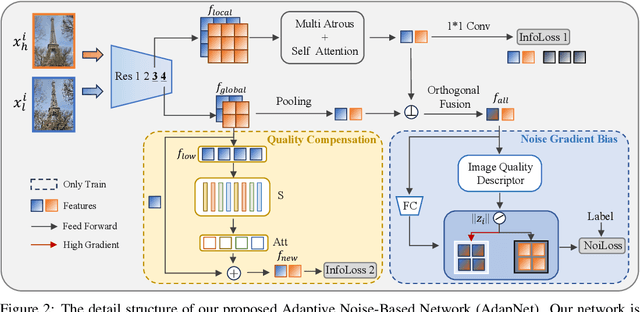

Abstract:Image retrieval aims to identify visually similar images within a database using a given query image. Traditional methods typically employ both global and local features extracted from images for matching, and may also apply re-ranking techniques to enhance accuracy. However, these methods often fail to account for the noise present in query images, which can stem from natural or human-induced factors, thereby negatively impacting retrieval performance. To mitigate this issue, we introduce a novel setting for low-quality image retrieval, and propose an Adaptive Noise-Based Network (AdapNet) to learn robust abstract representations. Specifically, we devise a quality compensation block trained to compensate for various low-quality factors in input images. Besides, we introduce an innovative adaptive noise-based loss function, which dynamically adjusts its focus on the gradient in accordance with image quality, thereby augmenting the learning of unknown noisy samples during training and enhancing intra-class compactness. To assess the performance, we construct two datasets with low-quality queries, which is built by applying various types of noise on clean query images on the standard Revisited Oxford and Revisited Paris datasets. Comprehensive experimental results illustrate that AdapNet surpasses state-of-the-art methods on the Noise Revisited Oxford and Noise Revisited Paris benchmarks, while maintaining competitive performance on high-quality datasets. The code and constructed datasets will be made available.
PVG: Progressive Vision Graph for Vision Recognition
Aug 01, 2023Abstract:Convolution-based and Transformer-based vision backbone networks process images into the grid or sequence structures, respectively, which are inflexible for capturing irregular objects. Though Vision GNN (ViG) adopts graph-level features for complex images, it has some issues, such as inaccurate neighbor node selection, expensive node information aggregation calculation, and over-smoothing in the deep layers. To address the above problems, we propose a Progressive Vision Graph (PVG) architecture for vision recognition task. Compared with previous works, PVG contains three main components: 1) Progressively Separated Graph Construction (PSGC) to introduce second-order similarity by gradually increasing the channel of the global graph branch and decreasing the channel of local branch as the layer deepens; 2) Neighbor nodes information aggregation and update module by using Max pooling and mathematical Expectation (MaxE) to aggregate rich neighbor information; 3) Graph error Linear Unit (GraphLU) to enhance low-value information in a relaxed form to reduce the compression of image detail information for alleviating the over-smoothing. Extensive experiments on mainstream benchmarks demonstrate the superiority of PVG over state-of-the-art methods, e.g., our PVG-S obtains 83.0% Top-1 accuracy on ImageNet-1K that surpasses GNN-based ViG-S by +0.9 with the parameters reduced by 18.5%, while the largest PVG-B obtains 84.2% that has +0.5 improvement than ViG-B. Furthermore, our PVG-S obtains +1.3 box AP and +0.4 mask AP gains than ViG-S on COCO dataset.
* Accepted by ACM MM 2023
DEDGAT: Dual Embedding of Directed Graph Attention Networks for Detecting Financial Risk
Mar 06, 2023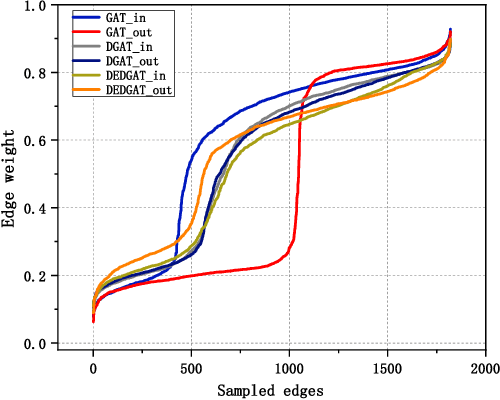
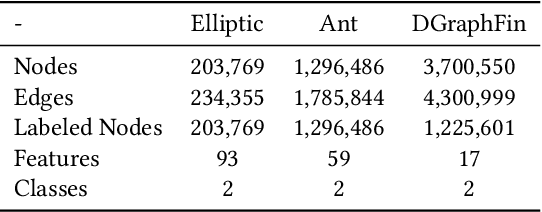
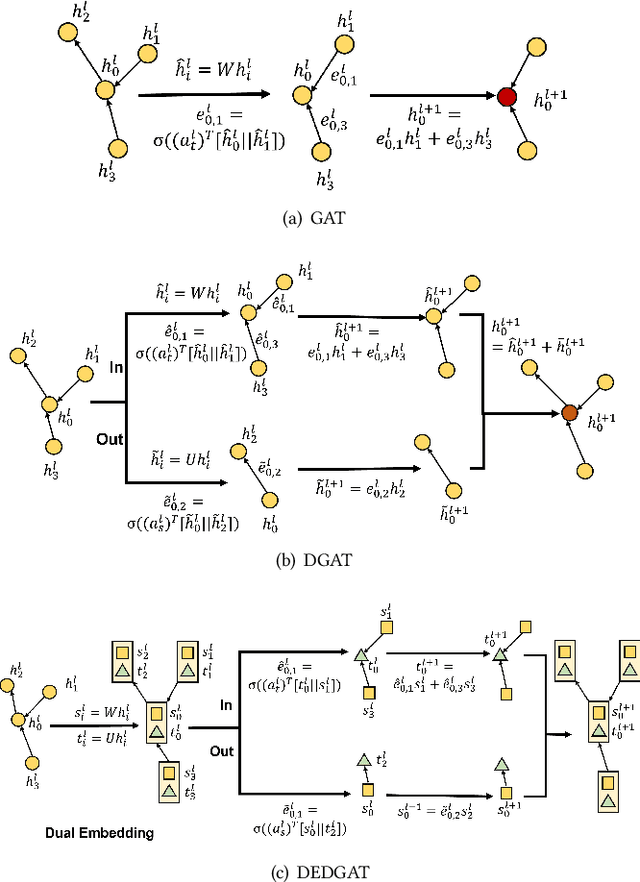
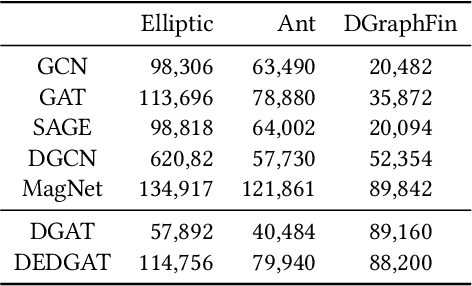
Abstract:Graph representation plays an important role in the field of financial risk control, where the relationship among users can be constructed in a graph manner. In practical scenarios, the relationships between nodes in risk control tasks are bidirectional, e.g., merchants having both revenue and expense behaviors. Graph neural networks designed for undirected graphs usually aggregate discriminative node or edge representations with an attention strategy, but cannot fully exploit the out-degree information when used for the tasks built on directed graph, which leads to the problem of a directional bias. To tackle this problem, we propose a Directed Graph ATtention network called DGAT, which explicitly takes out-degree into attention calculation. In addition to having directional requirements, the same node might have different representations of its input and output, and thus we further propose a dual embedding of DGAT, referred to as DEDGAT. Specifically, DEDGAT assigns in-degree and out-degree representations to each node and uses these two embeddings to calculate the attention weights of in-degree and out-degree nodes, respectively. Experiments performed on the benchmark datasets show that DGAT and DEDGAT obtain better classification performance compared to undirected GAT. Also,the visualization results demonstrate that our methods can fully use both in-degree and out-degree information.
 Add to Chrome
Add to Chrome Add to Firefox
Add to Firefox Add to Edge
Add to Edge